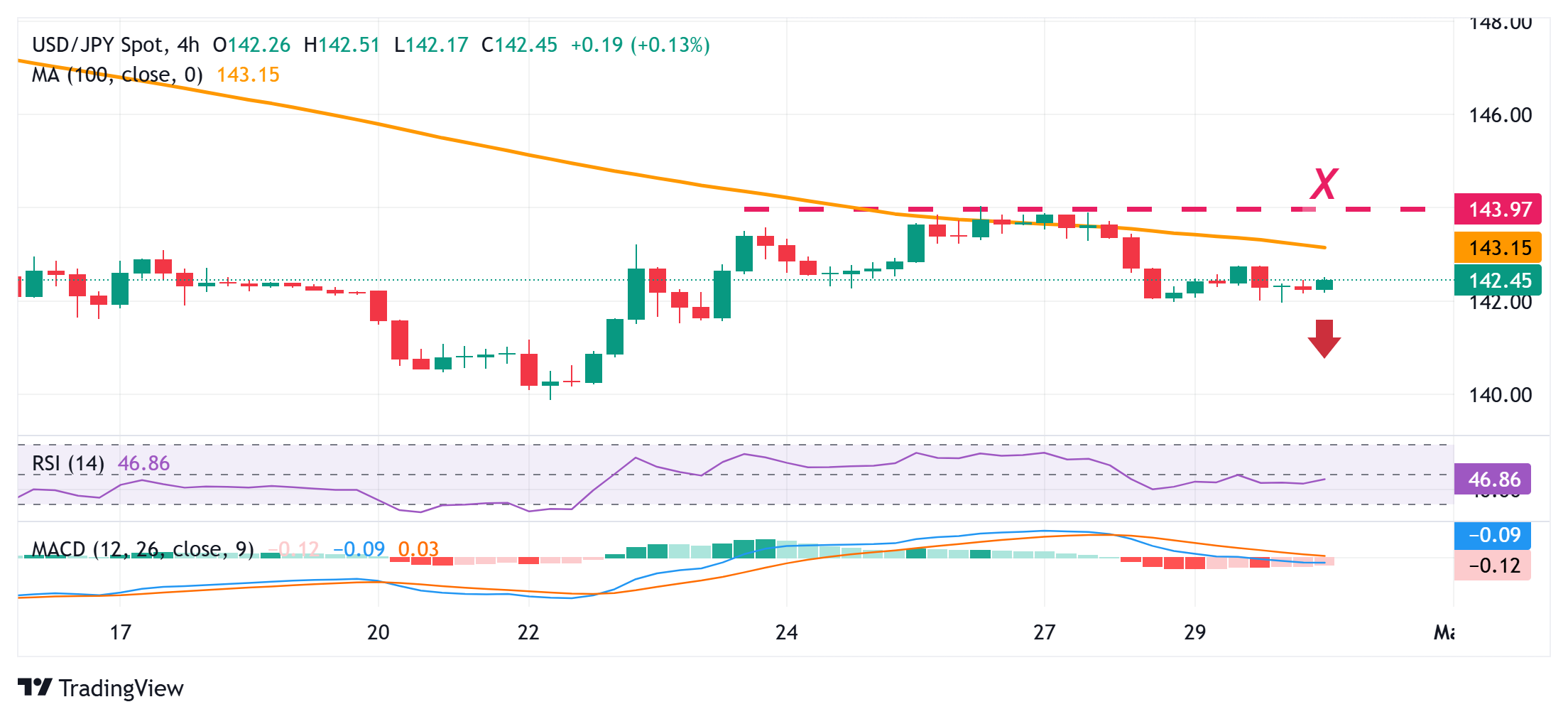Japanese Yen sticks to intraday losses; downside seems limited ahead of BoJ decision on Thursday
- The Japanese Yen drifts lower for the second straight day amid a positive risk tone and dismal domestic data.
- A modest USD uptick further supports USD/JPY, though the divergent BoJ-Fed expectations might cap gains.
- Traders might also refrain from placing aggressive bets ahead of the crucial BoJ policy decision on Thursday.
The Japanese Yen (JPY) remains depressed against its American counterpart heading into the European session on Wednesday as signs of easing US-China trade tensions undermine demand for safe-haven status. Furthermore, US President Donald Trump's decision to give flexibility on tariffs to US carmakers remains supportive of the upbeat market mood. This, along with disappointing domestic data, turn out to be key factors weighing on the safe-haven JPY. The US Dollar (USD), on the other hand, attracts some buyers for the second straight day and lifts the USD/JPY pair back above mid-142.00s.
Any meaningful JPY depreciation, however, seems elusive as traders might refrain from placing aggressive bets and opt to wait for the crucial Bank of Japan (BoJ) policy decision on Thursday. The central bank is widely expected to keep interest rates steady amid heightening risks to the fragile economy from US tariffs. However, signs of broadening inflation in Japan keep the door open for further BoJ policy normalization. This marks a big divergence in comparison to expectations for more aggressive easing by the Federal Reserve (Fed), which should cap the USD and benefit the lower-yielding JPY.
Japanese Yen remains depressed as easing trade tensions undermine safe-haven demand ahead of BoJ on Thursday
- US President Donald Trump signed an order that will allow US carmakers to reduce the amount they pay in import taxes on foreign parts. Moreover, White House officials said that parts made in Canada and Mexico that follow North American free trade rules would not face tariffs.
- This comes on top of progress on trade negotiations and hopes for further trade deals, which remains supportive of a positive risk tone. In fact, US Treasury Secretary Scott Bessent said earlier this week that many top US trading partners have made "very good" tariff proposals.
- Government data released earlier this Wednesday showed that Japan's Industrial Production shrank 1.1% in March, much more than expected. Adding to this, Japan's Retail Sales also fell short of estimates and grew 3.1% YoY in March, acting as a headwind for the Japanese Yen.
- The Bank of Japan kickstarts its policy meeting today and will announce its decision on Thursday. The central bank is expected to move cautiously and pause further interest rate hikes amid growing concerns that the new US tariffs could sharply slow Japan's economic growth.
- Expectations beyond the April meeting are divided amid mixed economic signals from Japan. However, persistent inflationary pressures and bumper pay hikes offered by big firms this year give the BoJ headroom to continue tightening its monetary policy this year.
- In contrast, the disappointing US Job Openings and Labor Turnover Survey (JOLTS) and the US Conference Board’s Consumer Confidence Index released on Tuesday strengthened the case for the resumption of the Federal Reserve's rate-cutting cycle in the coming months.
- In fact, the US Bureau of Labor Statistics (BLS) reported that US job openings dropped sharply, to 7.19 million by the last day of March from the 7.480 million (revised from 7.56 million) open positions reported in the previous month. This reading was below expectations of 7.5 million.
- Adding to this, the US Consumer Confidence Index slumped to 86.0 in April, or a nearly five-year low, amid concerns over the potential economic fallout from Trump's tariffs. Furthermore, the Present Situation Index and the Expectations Index fell to 133.5 and 54.4, respectively.
- CME FedWatch Tool puts the odds of a 25 bps Fed rate cut in June at 65%. Traders are also pricing in up to 100 bps in cuts by year-end, a key factor keeping the US Dollar near multi-year lows.
- Traders now look to Wednesday's key US data – the ADP report on private-sector employment, the Advance Q1 GDP, and the Personal Consumption and Expenditure (PCE) Price Index. Adding to this the US Nonfarm Payrolls report on Friday may provide insight into the Fed's policy outlook.
- In the meantime, the divergent BoJ-Fed policy expectations should continue to act as a tailwind for the lower-yielding JPY and cap the upside for the USD/JPY pair.
USD/JPY could accelerate the intraday positive move once the 142.60-142.65 immediate hurdle is cleared decisively

From a technical perspective, the USD/JPY pair earlier this week struggled to find acceptance above the 100-period Simple Moving Average (SMA) on the 4-hour chart and faced rejection near the 144.00 mark. The subsequent downfall and negative oscillators on hourly/daily charts validate the near-term negative outlook. That said, it will still be prudent to wait for some follow-through selling below the 142.00 mark before positioning for deeper losses. Spot prices might then accelerate the fall towards the mid-141.00s en route to the 141.10-141.00 region. The downward trajectory could extend further towards the 140.50 intermediate support before the pair eventually drops to the multi-month low – levels below the 140.00 psychological mark touched last week.
On the flip side, the 142.60-142.65 region is likely to act as an immediate hurdle, above which a bout of a short-covering could lift the USD/JPY pair beyond the 143.00 mark, towards the next relevant resistance near the 143.40-143.45 zone. A sustained strength beyond the latter should allow spot prices to conquer the 144.00 round figure. Acceptance above the latter would suggest that the currency pair has formed a near-term bottom and pave the way for some meaningful upside.
Bank of Japan FAQs
The Bank of Japan (BoJ) is the Japanese central bank, which sets monetary policy in the country. Its mandate is to issue banknotes and carry out currency and monetary control to ensure price stability, which means an inflation target of around 2%.
The Bank of Japan embarked in an ultra-loose monetary policy in 2013 in order to stimulate the economy and fuel inflation amid a low-inflationary environment. The bank’s policy is based on Quantitative and Qualitative Easing (QQE), or printing notes to buy assets such as government or corporate bonds to provide liquidity. In 2016, the bank doubled down on its strategy and further loosened policy by first introducing negative interest rates and then directly controlling the yield of its 10-year government bonds. In March 2024, the BoJ lifted interest rates, effectively retreating from the ultra-loose monetary policy stance.
The Bank’s massive stimulus caused the Yen to depreciate against its main currency peers. This process exacerbated in 2022 and 2023 due to an increasing policy divergence between the Bank of Japan and other main central banks, which opted to increase interest rates sharply to fight decades-high levels of inflation. The BoJ’s policy led to a widening differential with other currencies, dragging down the value of the Yen. This trend partly reversed in 2024, when the BoJ decided to abandon its ultra-loose policy stance.
A weaker Yen and the spike in global energy prices led to an increase in Japanese inflation, which exceeded the BoJ’s 2% target. The prospect of rising salaries in the country – a key element fuelling inflation – also contributed to the move.
Forex News
Keep up with the financial markets, know what's happening and what is affecting the markets with our latest market updates. Analyze market movers, trends and build your trading strategies accordingly.
